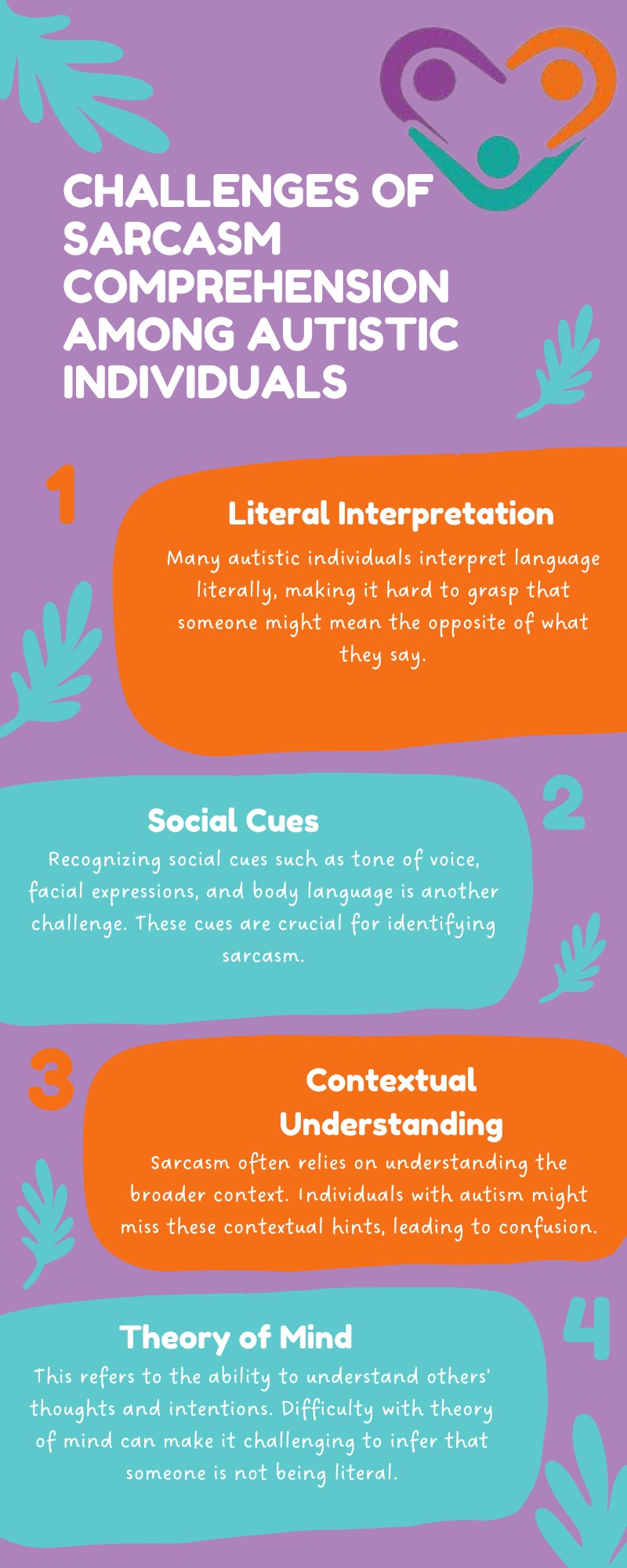Sarcasm is a form of speech where the speaker says something but means another, often the opposite. It is commonly used for humor, criticism, or to express frustration. The intonation, facial expressions, and context play significant roles in conveying the sarcastic intent. For individuals with autism, understanding sarcasm can be challenging, but available support and programs like social skills training and ABA therapy can help improve comprehension and communication in these situations.
For example, saying “Great job!” to someone who made a mistake is understood as sarcasm because of the tone and situation.
But that said, is sarcasm something that autistic individuals can understand? Let’s take a look.
Can an Autistic Person Understand Sarcasm?
Yes, an autistic person can understand sarcasm, but it may depend on the individual and their level of communication skills.
While many people on the autism spectrum may struggle with interpreting non-literal language such as sarcasm, others may have the ability to understand it once they are familiar with the context or tone in which it is used.
However, it is common for individuals with autism to take things more literally, especially if they have not yet developed the ability to read subtle social cues, including tone of voice or body language, which are often essential for understanding sarcasm.
In these cases, extra clarification or context may be needed for the individual to grasp the meaning behind sarcastic remarks.
Challenges of Sarcasm Comprehension in Autism
Individuals with autism often find it difficult to understand sarcasm. This is due to several factors unique to the autism spectrum such as:

Understanding these challenges is crucial for parents, caregivers, and individuals with autism themselves. It can pave the way for developing better communication strategies and fostering more effective social interactions.
Differences in Understanding Sarcasm
People with autism often face difficulties in interpreting sarcasm compared to their neurotypical peers. Sarcasm relies heavily on tone, body language, and contextual nuances, which can be challenging for those with autism to decipher.
Research has highlighted the disparity in sarcasm comprehension between autistic individuals and their neurotypical counterparts. That said, several elements affect the ability of individuals with autism to understand sarcasm, including:
- Cognitive Differences: Variations in cognitive processing, such as difficulty with abstract thinking, impact sarcasm comprehension.
- Social Awareness: Reduced sensitivity to social cues, including vocal tone and facial expressions, affects understanding.
- Experience and Exposure: Limited exposure to social interactions involving sarcasm can hinder development.
- Language Development: Challenges in language skills can interfere with interpreting nuanced speech.
Understanding these factors helps caregivers and educators develop better strategies to support individuals with autism in social settings. By recognizing the unique challenges faced, evidence-based interventions can be designed to enhance social comprehension and interaction.
How to Enhance Sarcasm Comprehension
Improving sarcasm comprehension in individuals with autism requires dedicated strategies that focus on building social skills and understanding contextual cues. Here are key approaches that can help:
Social Skills Training
Social skills training is an effective way to enhance sarcasm comprehension. Social skills training involves structured programs that teach essential social behaviors through role-playing, modeling, and reinforcement.
SST sessions typically cover:
- Recognizing social cues
- Expressing emotions
- Responding to social situations appropriately
This structured approach allows individuals with autism to practice and internalize the nuances of sarcastic expressions within a controlled environment.
Contextual Cues and Nonverbal Communication
Understanding sarcasm often relies heavily on contextual cues and nonverbal signals. Teaching individuals with autism to recognize these elements can significantly improve their comprehension of sarcastic remarks.
Key elements to focus on include:
- Tone of Voice: Sarcastic remarks often have a distinctive tone. Recognizing shifts in tone can be a valuable skill.
- Facial Expressions: Teaching to identify facial cues such as raised eyebrows or smirks associated with sarcasm.
- Body Language: Understanding gestures and posture that accompany sarcasm.
Employing visual aids and practicing these cues in varied scenarios can aid in better recognition and understanding.

Direct Instruction and Explanation
Direct instruction provides clear, concise explanations about the nature and usage of sarcasm. This approach can demystify sarcasm for individuals with autism by breaking it down into understandable components.
This method ensures that individuals have a foundational understanding, making it easier to identify sarcasm in real-life interactions.
With the help of these strategies, parents, caregivers, and educators can help individuals with autism develop the skills needed to comprehend sarcasm, enhancing their social interactions and overall communication abilities.
How to Support Individuals with Autism
Creating an environment that fosters understanding and growth is vital for individuals with autism, especially in the context of grasping nuances like sarcasm. Support through various strategies can significantly contribute to enhanced social interactions.
To help an autistic person understand sarcasm, it’s essential to build an environment that minimizes stress and encourages learning. A supportive society is characterized by consistency, predictability, and clear communication. Strategies include:
- Maintaining routines and schedules
- Providing clear and simple instructions
- Using visual aids and cues
- Establishing a calm and sensory-friendly space
Open communication is also crucial in helping individuals with autism develop social skills, including sarcasm comprehension. Encouraging an open dialogue and creating learning opportunities can be achieved through:
- Regularly engaging in conversations
- Encouraging questions and curiosity
- Practicing social scenarios through role-playing
- Using stories and examples to illustrate sarcasm
Lastly, professional support can be invaluable for parents, caregivers, and individuals with autism. Experts can provide tailored strategies and resources to improve sarcasm comprehension.
With the help of these strategies, parents and caregivers can create a nurturing and supportive environment to facilitate a better understanding of sarcasm in individuals with autism.

Conclusion
Sarcasm can be tricky, even for people without autism, but that doesn’t mean an autistic person can’t understand or even enjoy it. With time, patience, and clear communication, many autistic individuals can pick up on sarcastic cues or find their own way of interpreting humor.
It’s all about creating a space where understanding and connection can grow. Everyone processes the world differently, and those differences make our interactions more colorful and meaningful.
Sarcasm may not always come naturally, but with the right support and mutual effort, it can still be a shared experience. At Golden Care Therapy, we specialize in providing high-quality ABA therapy tailored to your child’s unique needs. We proudly offer autism services in New Jersey, Indiana, New York, Georgia, and Florida.
Our team is committed to delivering compassionate, evidence-based care that fosters growth and confidence. Contact us today to learn how we can support your family on this journey.
Sources:



